Inductors

Inductor Guide
There are cases where improvements in the power integrity (PI) of power amplifiers (PA) are required in order to suppress undesirable radiation (out-of-band radiation and spurious radiation) in the PAs of smartphones and other mobile wireless terminals. Permissible levels and values have been established for the undesirable radiation experienced with wireless communications not only by international standards agencies (ITU) and 3GPP (3rd Generation Partnership Project, which is a collaboration between groups of telecommunication associations), but also by the communication carriers themselves; these levels are subject to strict controls.
It is therefore considered necessary to improve RF signal quality using measures to suppress the noise in the power supply lines of PAs.


This article describes how to suppress the noise in the power supply lines featured in the power amplifiers of mobile terminals using chip ferrite beads and chip inductors in order to improve RF signal quality—that is, improve out-of-band radiation and spurious radiation.
Measures for improving RF signal quality using evaluation with wired connections
ACLR (*1) (Adjacent Channel Leakage Ratio) and SEM (*2) (Spectrum Emission Mask) are both featured among the items involved in the evaluation of RF signal quality using wired connections. These constitute the tests for evaluating spurious radiation (undesirable radiation) in channels adjacent to the RF signals.
This article describes the methods used to improve RF signal quality in cases where DC-DC converters are used for supplying the power of PAs.
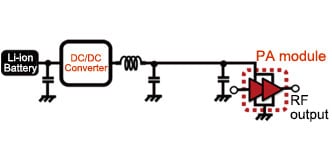
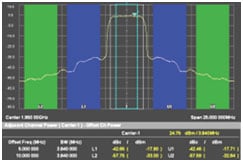
*1 Adjacent Channel Leakage Ratio (ACLR): Extent to which signals leak into adjacent channels
*2 Spectrum Emission Mask (SEM): Permissible level of the spurious radiation that leaks out-of-band
(* For more precise definitions, please refer to specialized documentation.)
The noise transmitted along the power supply line of a PA disturbs the power supply of the PA so it emerges in the PA output and adversely affects the RF signals.
The noise (F1) transmitted along the power supply line emerges as spurious radiation on both sides (F2-F1 and F2+F1) of the carrier due to the second-order distortion characteristics of the PA.

By identifying the frequency of power supply noise that adversely affects the RF signal quality, it is possible to initiate measures to suppress this noise.
For instance, in RF signal quality evaluation, the bandwidth of the frequency generally used for ACLR evaluation is centered on the carrier frequency (F2; it is 25 MHz under the W-CDMA standard and 50 MHz under the LTE standard).
If this is considered from the perspective of one side only, a width of 12.5 MHz from the carrier frequency (F2) under the W-CDMA standard and 25 MHz from the carrier frequency (F2) under the LTE standard is evaluated. It therefore follows that, in terms of the ACLR, the noise of the frequency (F1) below 12.5 MHz under the W-CDMA standard and below 25 MHz under the LTE standard is what adversely affects the RF signal quality.
The principal cause of the noise in the low-frequency bands is the switching noise of the DC-DC converters (the switching frequency of the DC-DC converters used for PAs in general ranges from 2 MHz to 10 MHz).
This means that in order to initiate measures to suppress the noise in the power supply lines of the PAs, the level of the switching noise of the DC-DC converters must be curbed.

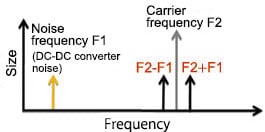
The measures shown in the figure below are an effective way of curbing the level of the switching noise of the DC-DC converters. Chip inductors in the LQW15CN series or the BLM15PX121SN1 chip ferrite bead can be inserted immediately after the output LC components (power inductor and output capacitor) of the DC-DC converter.

The results of taking the noise suppression measure described above were verified using an evaluation board.

We investigated whether, by inserting a filter into the circuitry, the loss produced by this component exerts an adverse effect on the power conversion efficiency of the DC-DC converter. The LQW15CN series of chip inductors and BLM15PX121SN1 chip ferrite beads have an ultra-low DC resistance; therefore, the effect on the power conversion efficiency eliminates problems.
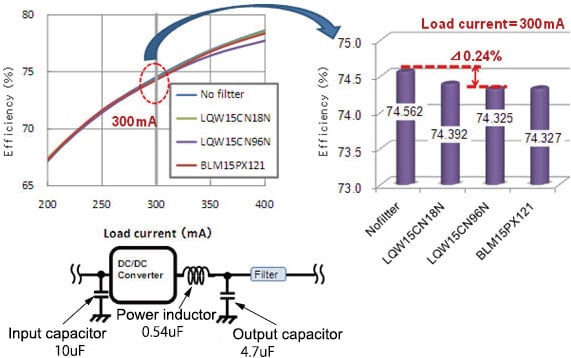
Provided below is an example of a noise suppression measure that was taken in an actual product.
We verified that the spurious radiation in the frequency band adjacent to the RF signals is improved by inserting the LQW15CN18NJ00 chip inductor immediately after the output LC components (power inductor and output capacitor) of the DC-DC converter.
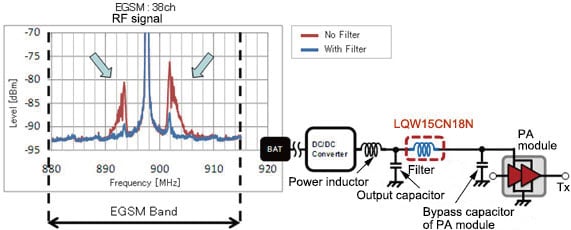
We investigated some ways and means used for improving the RF signal quality using evaluation with wired connections in the power supply lines of the PAs provided in mobile wireless terminals.
Conclusions: Noise suppression measures taken to improve the RF signal quality using evaluation with wired connections
By inserting a chip inductor in the LQW15CN series or the BLM15PX121SN1 chip ferrite bead immediately after the output LC components (power inductor and output capacitor) of a DC-DC converter, it is possible to curb the low-frequency noise (switching noise) of the DC-DC converter and, as a result, improve the RF signal quality.
Department Responsible: Application Development Sec. Product Development Dept. EMI Filter Division, Murata Manufacturing Co., Ltd.
The information presented in this article was current as of the date of publication. Please note that it may differ from the latest information.